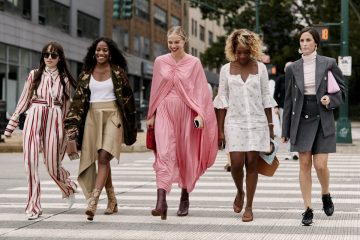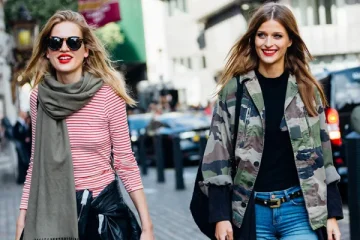Fashion Trend: A Deep Dive into Style Evolution

Fashion is more than clothing; it is a reflection of culture, history, and individuality. Every season introduces a new wave of styles, textures, and ideas that reshape how people present themselves. Understanding the dynamics of a fashion trend can help individuals stay relevant, elevate their personal style, and make conscious choices in a fast-moving industry.
What Defines a Fashion Trend
A fashion trend is not just a random change in clothing style. It emerges through social influences, cultural movements, and consumer behaviour. Trends can originate from celebrity wardrobes, street style, social media influencers, or even from unexpected sources like art and architecture.
Key characteristics of a fashion trend include:
-
Timeliness: It responds to cultural and seasonal moods.
-
Accessibility: Trends often adapt to be wearable for mass audiences.
-
Versatility: A strong trend influences multiple categories such as apparel, accessories, and footwear.
-
Longevity: Some trends are short-lived, while others evolve into timeless staples.
The Cycle of Fashion Trends
Fashion follows a recurring cycle, often referred to as the “trend lifecycle”. It consists of five key stages:
-
Introduction – A designer or influencer introduces a new style.
-
Rise – Media coverage, social buzz, and early adopters create demand.
-
Peak – The style becomes mainstream, visible in stores and widely embraced.
-
Decline – Oversaturation leads to a loss of exclusivity.
-
Obsolescence – The trend fades, paving the way for new innovation.
The Role of Social Media in Shaping Trends
Social platforms have transformed how quickly a trend spreads. Apps like Instagram, TikTok, and Pinterest are central to the rapid adoption of fashion. A single viral video can propel a niche aesthetic into mainstream popularity overnight.
Some social media-driven trends include:
-
Micro aesthetics such as “cottagecore” or “dark academia”
-
Celebrity street style replication
-
Fast-moving seasonal challenges that highlight specific outfits or accessories
Seasonal Fashion Trends
Every year, fashion weeks across London, Paris, Milan, and New York set the tone for seasonal fashion. Designers showcase collections that influence colour palettes, cuts, and materials.
Spring and Summer Trends
-
Light fabrics like cotton and linen
-
Pastel and floral prints
-
Minimalist sandals and woven bags
-
Breezy silhouettes like maxi dresses
Autumn and Winter Trends
-
Layering with knitwear and coats
-
Neutral tones complemented by jewel accents
-
Leather boots and oversized scarves
-
Structured tailoring for sophistication
Sustainable Fashion Trends
Sustainability is no longer optional in the modern fashion landscape. Consumers demand eco-conscious practices, and brands are rethinking production methods.
Key sustainable movements include:
-
Upcycling and thrifting – Repurposing vintage clothing
-
Slow fashion – Investing in quality, long-lasting pieces
-
Eco-friendly materials – Organic cotton, bamboo, and recycled fibres
-
Minimalism – Prioritising capsule wardrobes to reduce waste
Genderless and Inclusive Fashion
Modern fashion embraces inclusivity more than ever before. Gender-neutral designs and size-inclusive collections are reshaping the industry’s outlook. These trends highlight that style is a form of self-expression unrestricted by stereotypes.
Examples include:
-
Oversized silhouettes that work across genders
-
Adaptive clothing designed for accessibility
-
Runways featuring models of diverse body types and backgrounds
The Impact of Technology on Fashion Trends
Technology is pushing fashion into exciting new directions. Digital fashion shows, virtual try-ons, and AI-generated designs are revolutionising how trends are introduced and consumed.
Emerging tech-driven trends:
-
Virtual clothing for online avatars
-
Smart fabrics with performance-enhancing features
-
3D printing for custom fits and designs
-
Augmented reality shopping to improve consumer experience
How to Adapt Fashion Trends to Your Style
While trends come and go, personal style is about balance. To adapt fashion trends effectively:
-
Pick selectively: Not every trend suits every personality or body type.
-
Blend with basics: Pair bold trends with timeless staples like denim or a crisp white shirt.
-
Stay authentic: Use trends as inspiration, not rules.
-
Experiment affordably: Try emerging looks through high-street retailers before committing to luxury versions.
FAQs on Fashion Trends
What is the difference between a fashion trend and a fashion fad?
A trend evolves gradually, has staying power, and influences multiple industries, while a fad is short-lived, often disappearing within weeks or months.
How long does a fashion trend usually last?
On average, a strong trend lasts between one and three years, depending on consumer adoption and cultural relevance.
Are fashion trends the same worldwide?
While globalisation has created similarities, local cultures, climates, and traditions heavily influence how trends are interpreted regionally.
Can old trends come back into style?
Yes, fashion is cyclical. Retro and vintage styles often reappear every 20–30 years, refreshed with modern elements.
How can someone stay updated with fashion trends?
Follow fashion magazines, watch runway shows, engage with style influencers on social media, and observe high-street brand releases.
Is following every trend necessary to be fashionable?
Not at all. True fashion is about confidence and self-expression. Incorporating selected trends into your personal style is far more impactful than chasing every new look.











